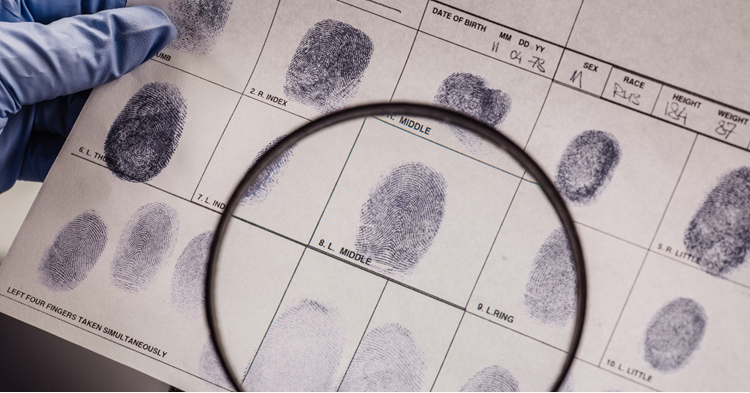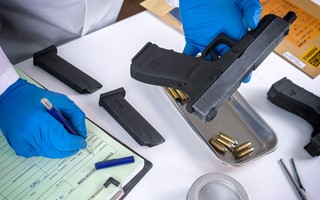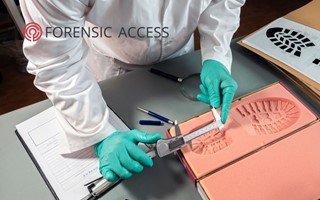News February 08, 2023
When shopkeeper Thomas Farrow and his wife Anne were murdered in 1905, a bloody thumbprint found at the scene made this the first British murder to be solved and prosecuted using fingerprint evidence.
This case seemed to herald a new dawn of evidence. One where anyone who left a fingerprint at a crime scene could be caught and prosecuted. However, the reality is somewhat different. As we explore in this in-depth article which covers:
- How fingerprint evidence includes more than fingerprints
- Capturing the fingerprint
- The importance of fingerprint quality
- Analysing fingerprints - opinion not fact
- Opportunities to challenge fingerprint evidence
- What can influence fingerprint analysis outcomes?
More than fingerprints
Did you know that fingerprint evidence can include more than prints of your fingers? The term 'fingerprint' actually covers a wide range of areas which includes
- The entire palm surface from the wrist to the tips of the fingers.
- The pieces of skin between the fingers.
- The friction ridges along the inner surface of the fingers and thumbs (known as phalanges)
The arrangement of friction ridge details, which make up fingerprints, are unique to each individual. They are made from raised areas of skin called 'ridges' which are separated by depressed areas called 'furrows'. Fingerprints - as in the arrangement of friction ridge detail patterns - remain essentially unchanged throughout life. And no two people have been found to have the same arrangement of friction ridge detail, including identical twins.
Prints from toes and feet can also be used to identify someone as everyone has individual arrangements of friction ridge detail - as with fingers and hands, prints can be taken from the heel to the tips of the toes. This uniqueness and the persistence of fingerprints - as well as palm, toe and footprints - means these marks provide a useful way to identify someone.

Capturing the fingerprint
Watch any police drama on TV and you'll have seen the basics of gathering fingerprint evidence. Black carbon powder is dusted onto surfaces, sticking to the sweat left by the friction ridges of the fingerprint. These marks are then photographed or lifted using DCF tape which is fixed to a plastic sheet so it can be stored as evidence.
If the prints are on a movable item, they can be developed using specialist fingerprint enhancement equipment and techniques. The context in which a fingerprint is found is important. Which is why it's good practice to record the location and position of the fingerprint to support later analysis.
The importance of fingerprint quality
Finger and palm prints are usually left at a crime scene by chance which can often result in a limited number of prints of varying quality. This frequently leads to partial marks, like the side or tip of a finger, being deposited. However, all is not lost, as low quality and partial prints can be used to establish someone's identity - as long as the recovered print contains enough information.
Analysing fingerprints - opinion not fact
Although fingerprint evidence was presented in court for many years as fact, the forensic regulator now classes the evidence as expert opinion. Even when experts work in the same organisation and use the same equipment, techniques and approaches, they can make different judgements on the same evidence.
When fingerprints are analysed and compared, the outcomes can be classified into four different groups:
- Identified - the mark can be confidently attributed to a particular individual as there is sufficient quality and quantity of fingerprint detail for the fingerprint practitioner to assess and match.
- Excluded - enough fingerprint features do not match to conclude that marks did not come from the same person.
- Inconclusive - the fingerprint mark does not contain enough and/or sufficient quality detail for a viable comparison and gives inconclusive results.
- Insufficient - the fingerprint mark contains such low quantity and/or poor quality detail that a reliable comparison cannot be made. The detail is not clear enough or it has been so compromised by external forces that the evidence is unreliable.
A specialist should be able to explain the limitations of fingerprint evidence to a legal team or jury.
Opportunities to challenge fingerprint evidence
When you receive a streamlined forensic report (SFR) issued by a fingerprint bureau, it will report initial fingerprint evidence findings. However, because different bureaus record different information, the information on the SFR can vary and may not give you the full picture.
Information you might expect to see includes:
- Which finger, thumb or palm print at the crime scene has been identified as the crime scene mark.
- The origin of the crime scene mark - this is not always clear but it should include a crime scene number.
- Details of other marks previously identified in the case - you'll likely find these on later pages of the SFR.
You may also find you have additional SFRs to deal with if other marks are compared at a later stage. These additional marks are often relied on if an individual enters a not guilty plea.
When fingerprint evidence is classified as inconclusive, legal teams can bring in a fingerprint expert to carry out their own analysis of the marks. The SFR is only ever a starting point. It provides basic information that can be explored and potentially challenged by a fingerprint expert in two common ways.
Context
Marks used to identify the presence of someone at a scene. For example, someone who lawfully visited the scene could have left a finger, thumb or palm print in a location and at an orientation that eliminates them from the inquiry.
Length of time
The moisture content of a fingerprint can have a major impact on the length of time the mark lasts upon a surface. Watery sweat typically evaporates fairly quickly, whereas fatty sweat - or sweat which combines water and fat - can last longer. Sometimes this can be weeks or months rather than days depending on the level of disturbance (like cleaning or movement of material against the print).
Once a fingerprint is deposited, the length of time it persists on a surface is influenced by:
- Its composition
- The amount of matter deposited
- The physical properties and condition of the surface
- The degree of handling or disturbance
- Its position
- The environmental conditions
As each of these factors are variable there is currently no reliable technique to accurately determine the age of a latent fingerprint.
What can influence fingerprint analysis outcomes?
A fingerprint identification is open to challenge and can occasionally be found to be wrong. As in the case of a fingerprint found at the scene of a serious terrorist incident in the US. The print was matched to one on a computer database and the match verified by three experts. However, this was later found to be wrong. So, although rare, misidentifications can happen.
Why don't we use probability to match fingerprints?
Attempts have been made to introduce fingerprint analysis technology using statistical models that aim to predict whether there's a strong, moderate or weak likelihood of a fingerprint being a match. However, all these models have failed, in part because they do not take into account the wealth of friction ridge detail which experts include in their analysis and comparison.
How fingerprint experts ensure their opinion is valid
Independent analysis
For an expert's opinion of a fingerprint to stand up in court, the analysis needs to be undertaken independently. Contemporaneous notes made by the previous expert should not be shared with the specialist or it risks jeopardising the results of their review. The independent fingerprint expert will make their own notes and will only view the original notes if there is a difference of opinion.
Objectivity
Fingerprint experts also need to ensure they remain as objective as possible in their analysis. The Forensic Science Regulator recognises that cognitive bias - including cultural and contextual biases - have the potential to influence fingerprint decision making. To prevent outcomes being based on assumptions over evidence, fingerprint experts mitigate biases by following the relevant cognitive bias guidance and undertaking training.
Making the most of fingerprint evidence
Working with a qualified and highly experienced fingerprint expert can add huge value to your legal team. Get in touch with our casework team to find out how we can help on 01235 774870 or at science@forensic-access.co.uk.


